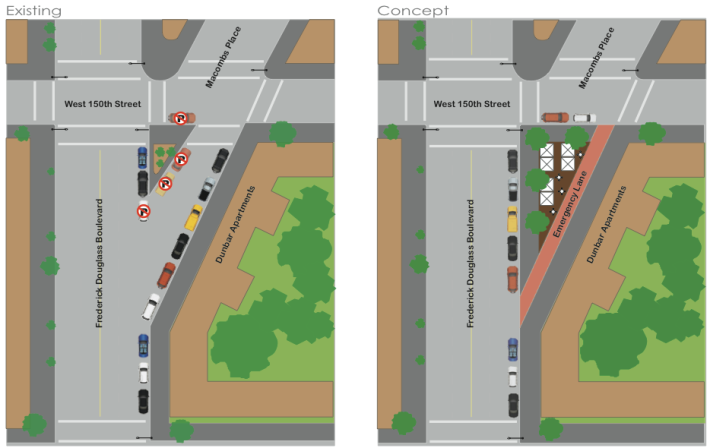
Manhattan Community Board 10's transportation committee ended months of foot-dragging this week by backing a road diet for Morningside Avenue in Harlem. It's not quite a brand new day at CB 10 though: A community effort to convert a short, irregular block into a public plaza still has an uphill climb at the Harlem board. While there's a substantial local coalition backing the project, a cadre of outspoken opponents use the existing street as a drop-off zone for their apartment building and don't want to see any changes.
The intersection of Frederick Douglass Boulevard and Macombs Place near 150th Street is a tricky place to walk. Drivers heading north on Frederick Douglass can veer right, making a high-speed turn onto Macombs Place. Walking across the street is risky: The long, low-visibility intersection doesn't have a crosswalk and is usually clogged with illegally parked cars. Within one block of the plaza site, there were 30 collisions resulting in five injuries from August 2011 to June 2013, according to NYPD data compiled by plaza advocates.
The effort to bring a plaza to the space is led by Harlem Congregations for Community Improvement, HERBan Farmers' Market, the Bradhurst Merchants Association, and Harlem Community Development Corporation, a unit of Empire State Development.
They have gathered nearly 300 signatures for the plaza and secured support for their application to DOT's plaza program from, among others, Bethany Baptist Church, the Polo Grounds Towers Resident Association, Council Member Inez Dickens, former Council Member Robert Jackson, WE ACT for Environmental Justice, Transportation Alternatives, and Harlem Hospital Center [PDF].
Last July, the coalition held a town hall meeting at Jackie Robinson Recreation Center that attracted dozens of people to discuss the plaza idea. In October, they hosted a one-day plaza demonstration on a Thursday afternoon, featuring free food and activities like tai chi demonstrations. Surveys from participants that day showed mixed feelings about whether the current intersection is dangerous, but overwhelming support for creating a plaza there.
Tupacamaru Tiwoni is the founder of HERBan Farmers Market, which operates weekly on Mount Morris Park West and would expand to Bradhurst Plaza. She also lives with her children right next to the plaza site in the Dunbar Apartments, where she was raised. “If you support a safer place to cross the street in this area, if you support an outdoor space that strengthens community... I urge you to vote in support of this project," she told the committee. “We want to bring fresh food to this community... It’s my community. It’s home to me."
The plaza coalition was looking for the board to support eight one-day demonstrations on weekends this summer, to build momentum for a permanent plaza design by DOT.
"If the community board supports this, we want to have a design charrette, which is a visioning session, and have the community come up with some ideas of how they would like to see that spot beautified," said Tom Lunke, director of planning and development at Harlem CDC.
Opponents, led by the Dunbar Residents Association and a pair of nearby block associations, don't want that to happen. They picketed the demonstration plaza last October and would like to see the street remain the way it is, suggesting the farmers market instead set up in Jackie Robinson Park.
“People are trying to shove this thing down our throats," said Bobby Jones, president of the Dunbar Residents Association, adding that he had 700 signatures on a petition against the plaza. He claimed that a plaza would make it difficult for Access-A-Ride vehicles and school buses to drop off children or the disabled. With the plaza, the closest curb to the building would be just a few feet farther away than it is now. "To interfere with their ability to be picked up or dropped off, that’s tragic," he said.
Even though he lives in the same building as Tiwoni, who is hoping to bring a farmers market to the plaza, Jones claimed that plaza supporters were either misinformed or not local residents. "What they did is they got a bunch of vicious people not from our neighborhood," Jones said, "and a few residents from our neighborhood, and they misinformed them."
On the board, the most outspoken opponent was Barbara Nelson, who objected to the loss of parking and said the plaza would restrict emergency access (the concept plan includes a fire lane).
In the end, the acting chair of the transportation committee, Karen Horry, negotiated a plan to hold three or four one-day plaza demonstrations, not eight, and to host another town hall forum to allow the public to offer feedback on the demonstrations and gauge support for a permanent design.
The solution did not please Jones, who wanted to see the plaza proposal rejected entirely, but supporters saw it as progress. "This is a big step," Tiwoni said after the meeting. "That they're willing to let us try is wonderful."





